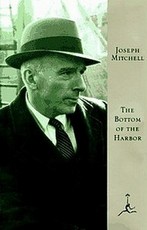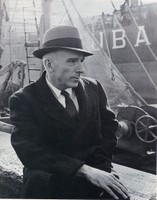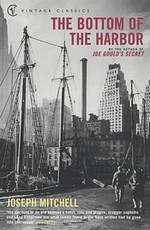
Margaret Fishback was among the most commercially successful poets of the 1930s, a prolific writer of comic verse who probably sold more books and had more poems published in more magazines than the better-known Ogden Nash. I doing some research on Fishback recently, I was startled to see the byline on a short portrait that appeared in several newspapers in February 1932: Joseph Mitchell. Yes, Joseph Mitchell, the author of Joe Gould’s Secret and legendary New Yorker writer who came to work daily for decades after publishing his last article for the magazine.
This piece was written in 1932, six years before Mitchell joined The New Yorker. At the time, Mitchell was just 24, a few weeks short of getting married, and working for the New York Herald Tribune. He’d begun to get a name for his color pieces, usually sketches of odd characters in the city — from bartenders to circus owners. A portrait of an author with a new book out, a soft piece to help sell Fishback’s first collection, I Feel Better Now, would have been a pretty mundane assignment compared to what would become his signature.

Not that the book needed much help. Published the same week that Mitchell’s article appeared, by the end of March, I Feel Better Now had gone through six printings.
NEW YORK. Feb. 13—Margaret Fishback. a young woman who likes to sit on summer nights in the somber beer houses which line the Hoboken waterfront and talk to the reminiscent sailors, said she wrote the casual verses in her book, I Feel Better Now, while riding to work on a Fifth Avenue bus and while eating lunch in a restaurant in Pennsylvania Station.
“And I wrote them on the backs of speakeasy cards,” she said, “and I wrote them while dressing to go out to dinner with some gent or other. And I wrote them while walking over the Brooklyn Bridge to see our absurd skyline. And on the Staten Island ferry. And on the bench. You know, everywhere.”
Miss Fishback has had long hair since she was a child. It is the color of corn shucks. She always has a good time. She likes elevator operators and bartenders. She gave the first autographed copy of her book to a conductor on a Fifth Avenue bus.
She lives in an old-fashioned house at 222 E. Sixty-first Street with Elizabeth Osgood, who is head of the proofroom at Appleton’s. There are 19 poplar trees on the block. There are also two churches but she does not known much about them.
“No, I don’t know what kind of poplars they are,” she said. “Lombardy poplars, maybe. I don’t know anything about nature. Do you like beer? I don’t care for it. The foam chokes me. All the people I know like beer. Over in Hoboken they live on it. You know. I have a lot of fun washing my hair. I like shower baths.
“The reason I started running around is because there are a lot of cats in the back yard of my home. And there’s a lady who always turns the radio on when they play ‘When the Moon Comes Over the Mountain.’ I never went around to speakeasies until they began playing that. One night last summer I heard that song over and over. I got out of the house and went to the Palace, and the first thing I knew a woman named Kate Smith was singing it all over the place. Then I went to a speakeasy.”
Miss Fishback is an advertising copy writer for Macy’s. She is called “the highest paid advertising woman in the world,” but she laughs heartily whenever she hears that she is. She came to New York eight years ago, found a job in a ballet, danced in various opera companies at $1 a night and $1 for each rehearsal, wrote poems for F. P. A.’s [Franklin P. Adams] column in the World under the name of Marne and always had a good time. She is a graduate of Goucher College. There she was a friend of Sara Haardt, who is the wife of H. L. Mencken.
“Mencken is the most attractive man I ever met,” she said. “I like men. I never was married, but I have had my troubles. You can be sure I have had my moments. Hell, I’m not a lady poet. I’m not literary. I like to get around. The reason I’m not a married woman is because I don’t have time. I work from 9:15 to 6:30. I’m always in a hurry. It wouldn’t be fair to marry. I’m too interested in my work.”
Miss Fishback is a very lovely young woman. She does not like to play tennis, cook, sew, or play bridge. She does not like parrots. She is entranced by the commonplace. She buys chestnuts on a windy corner, finds a worm and writes “a triolet on an enviable existence.” Walking around New York she reaches the Garlic Belt and decides that “on Bleeker Street the babies’ noses aren’t pampered by the scent of roses.” and under the “L” she decides that “on Second Avenue the babies howl as if they had the rabies.”
The titles of her poems are indicative of her personality — “A tomato is all right in its place,” or “Capitulation within the city limits, preferably the East Fifties.” or “No duels, drama, or bloodshed to speak of,” or “Lines on watching a mother at her crooning,” or “Orange juice and a quick swallow.” She wears bracelets made from the hoofs of elephants. She likes to wear sweaters. She writes triolets in Maine bathtubs, and she swims with a great deal of pleasure, and she has two favorite drinks.
“I like an old fashioned,” she said, “if it’s made with a great deal of care. But I can care violently for sidecars.”
Born in Washington, D.C. in 1904, Margaret Fishback attended Goucher College outside Baltimore, where she became friends with Sara Haardt, who later married H. L. Mencken. She then headed to New York City. She took whatever work she could, including dancing in the chorus at the Metropolitan opera, until, on the strength of a few poems she’d sold to F. P. A., she walked into Macy’s department store and proposed to go to work in their advertising office.

They accepted, and she would remain with the store over ten years. Many newspaper stories suggested she was at one time the highest-paid woman in advertising, though she always dismissed this as unsubstantiated nonsense. (Though, given the pay inequality that prevailed at the time, it probably wouldn’t have takem much to claim the title.)
Her copy for Macy’s was, in some ways, more absurd and edgy than her poetry. An early item claimed that cows were positively thrilled to be giving up their lives for Macy’s latest line of purses. Fishback used to roam the store in search of odd items to boost, once proclaiming that a two-foot long cake tester she found in the kitchen department was just the thing when it came time to bake a two-foot tall cake. (The store ended up selling thousands.) And she was unapologetically on the side of women as the wiser of the two sexes, as demonstrated by this ad cartoon from 1938:

Fishback once said she started writing poetry as a reaction to seeing other people hold up writers as demigods. “I’m not literary,” she would demur. “I do things by ear.” And she never got too sophisticated in her poesy: indeed, as it sticks to simple meters and always rhymes, it might be more accurately called verse than poetry. But her early poems could be subtle and flirt with complex effects:
View From a Fifth-Floor Fire Escape
An underfed ailanthus tree
Contributes animatedly
One bright, intrepid splotch of green.
And here and there through the ravineAn enterprising ray of sun
Contrives to have a little fun
By wriggling through a window just
To call attention to the dust.And though it’s messy in the street,
The sky above is large and neat.
And from this fire escape of mine
The cloud effects are very fine.Along about this time of day
Despite the roof across the way
That harbors shirts hung out to dry
Against the valiant Gotham sky.
The poems in I Feel Better Now draw directly from Fishback’s own experiences: working, commuting, living in a fifth-floor walkup with no view except from the fire escape:
It may be just as well that I
Can’t have a penthouse in the sky.
Perchance it’s just as well to be
Whete it’s impossible to see
The rivers and the boats unless
I wash my face and change my dress
And hop a crosstown trolley car.
This was something new in 1932 and working women responded with enthusiasm. “Reading Miss Fishback is contagious business,” wrote a woman reviewer. “You stop strangers in the trolley car or in the subway and begin to read to them aloud.” Fishback’s poems could be found almost every week in one or another magazine: from The New Yorker and Vanity Fair to Ladie’s Home Journal and the women’s sections of newspapers all over. Enough to collect for a second book, Out of My Head (1933).

With few points of reference, Margaret Fishback was often compared to Dorothy Parker, though Parker’s poetry was far more acidic and her fiction far more serious than the lightly comic stories she began to write. On the other hand, her work was positively biting compared to the warmer verse of Phyllis McGinley.
Her life and her voice took on a new tone in 1935 when she married Alberto Antolini, a buyer at Macy’s. She was undoubtedly the only poet whose engagement was announced in the pages of Sales Management magazine.
Her third book, published the same year, I Take It Back, was a little sunnier. The title was chosen by her husband and reviewers noted that it had “far more of sentiment and less of wit than I Feel Better Now. “The mighty Amazon has washed the poison off her darts and her winged shafts of poesy no longer sting.” Antolini convinced Fishback to move to the suburbs (Camden, New Jersey) — even though she had early written a poem about her own “Suburbaphobia”:
What meagre charm I had before
Expires the moment that the door
Of any suburb-going train
Clangs shut. And I do not regain
My normal joie de vivre until
I leave each flagrant daffodil
And buttercup behind, hell-bent
On getting back to God’s cement.
Her life and writing changed again in 1941, when she gave birth to their son, Anthony. She left Macy’s days before the delivery, and became a stay-at-home mom. She continued to write and publish poems — dozens and dozens about Tony — and slowly took on freelance copywriting work.
She remained at home, taking an active part in Tony’s life (one interviewer found her assembling five hundred gift bags for a school fest) until he went away to college in 1958. Then she returned to advertising, but moved from Herald Square up to Madison Avenue, joining Young & Rubicam and then Doyle Dane Bernbach a year later. Fishback was there to witness the change in culture depicted in the TV series Mad Men, as print and radio ads began to take a distant backseat to television and “branding.” And she continued to publish: as late as 1966, her poems and comic anecdotes could be found in Look magazine’s “Look on the Light Side” section. One of her last contributions to Look was a declaration of her failure to be that thing an advertising professional most wanted to encourage: a competitive consumer.
Underprivileged
Our living standard is so low,
We’ve but a single radio.No wonder that our children fret
With just one television set.No doubt our solitary phone
Feels unendurably alone.But most traumatic of all scars —
We haven’t ever got two cars!
Margaret Fishback died in 1985. Kathleen Rooney made Fishback the protagonist of her 2018 novel, Lillian Boxfish Takes a Walk. Fishback’s poetry books are long out of print and somewhat scarce, though One to a Customer (1938), which collects her first four collections, can be found on the Internet Archive (link).
Note: Margaret Fishback the comic versifier should not be confused with Margaret Fishback Powers the Christian poet.



 “Mitchell [was] a North Carolinian who became a New Yorker. He went straight from the University of North Carolina to a New York newspaper [The New York Herald Tribune–ed.]. First a reporter, he quickly turned into a feature writer, and then he became an essayist, the best in the city. [He joined the staff of
“Mitchell [was] a North Carolinian who became a New Yorker. He went straight from the University of North Carolina to a New York newspaper [The New York Herald Tribune–ed.]. First a reporter, he quickly turned into a feature writer, and then he became an essayist, the best in the city. [He joined the staff of  The other five are a kind of writing for which there is no name. Each tells a story, and is dramatic; each is both wildly funny and so sad you can hardly bear it; each tells its story so much in the words of its characters that it feels like a kind of apotheosis of oral history. Finally, like the Icelandic sagas, each combines a fierce joy in the physicality of living with a stoical awareness that all things physical end in death, usually preceded by years of diminishment. One winds up admiring Mitchell’s characters (all real people), loving them, all but weeping for them, maybe hoping to live as gallantly.
The other five are a kind of writing for which there is no name. Each tells a story, and is dramatic; each is both wildly funny and so sad you can hardly bear it; each tells its story so much in the words of its characters that it feels like a kind of apotheosis of oral history. Finally, like the Icelandic sagas, each combines a fierce joy in the physicality of living with a stoical awareness that all things physical end in death, usually preceded by years of diminishment. One winds up admiring Mitchell’s characters (all real people), loving them, all but weeping for them, maybe hoping to live as gallantly.